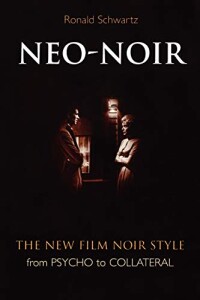 Craig Clarke wrote this review.
Craig Clarke wrote this review.
Ronald Schwartz is a film scholar with several books to his name. His main specialty is Latin American cinema, but he also holds a place in his heart for film noir of the past and present. His previous book on the subject Noir, Now and Then: Film Noir Originals and Remakes (1944-1999) was a survey of those classic films that have since been reimagined for the modern age. This concept flows easily into his most recent work, Neo-Noir: The New Film Noir Style from Psycho to Collateral. It covers those films that are noir-ish in scope but were made after the 1940s and 1950s (the accepted period of noir’s heyday) and are not simply remakes of earlier films noir.
The first statement Schwartz made in Neo-Noir that got my attention was that film noir is not a conscious genre, but an “unconscious stylistic movement” recognized by French critic Nino Frank (who coined the term) in 1946, several years into its existence. He says that these films shared a mood and “a similar photographic, artistic, and thematic style” but that “no American director during that period ever used the word ‘noir’ nor did he or she set out to create a style or genre.”
Assuming this information is accurate, it is enlightening to a merely intermediate-level noir fan like myself, who assumed that these movies about disillusioned saps who never get the girl were just another example of Hollywood copying its own prior successes. But it looks as if film noir was simply an idea whose time had come: the post-war confusion of soldiers returning home combined with the writings of such hard-boiled stylists as Cain, Chandler, Hammett, and Woolrich and the influence of European expressionist cinema all came together into a cohesive whole whose impact can still be felt today in the neo-noir films of the modern day.
Beginning with 1960’s Psycho (which appeared only two years after the release of Orson Welles’ Touch of Evil, widely considered to be the final film noir), Schwartz has done an admirable job of covering the highlights of neo-noir with reviews of what he considers the 32 films most representative of the style. In addition to articles presented in chronological order on the “usual suspects” (like The Usual Suspects) without which any retrospective of neo-noir would surely remain incomplete (Chinatown, Body Heat, L.A. Confidential, and The Last Seduction, for example), he also makes persuasive arguments for the inclusion of unexpected choices like In the Bedroom, The Manchurian Candidate, In the Cut, and even Vanilla Sky over its Spanish original, Open Your Eyes (Abre los Ojos).
This type of film criticism automatically brings up questions due to its very subjectivity. Each reader will surely argue why certain movies should have been omitted in favor of their obviously better choices. (I certainly wonder why Blood Work or Out of Time were chosen as more representative than, say, Dead Again or One False Move, both superior films.) The remaining number are catalogued in the exhaustive filmography (650 films!) included at the back of the book. Despite its $30 price tag (for a 150-page paperback), the depth and breadth of Neo-Noir makes it required reading for anyone longing to be a serious fan of films made in the modern noir style.
(Scarecrow Press, 2005)
